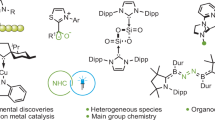Abstract
Carbodicarbenes are a special class of bisylidic CL2 compounds, the so-called carbones. Carbones are divalent carbon compounds, in which a four-electron carbon atom in the oxidation state of zero is bound by two σ-donor ligands L via donor-acceptor interactions, resulting in the formulation L→C(0)←L. In carbodicarbenes (CDCs), the L ligand is a N-heterocyclic carbene (NHC) or any other singlet carbene species. Comparable to “classical” bisylides, CDCs possess two lone pairs of electrons at the central carbon atom, thus making them stronger σ-donors than conventional carbenes like NHCs. These unusual donor properties make CDCs unique and highly potent ligands for transition metals and catalysis. This chapter summarizes the exciting developments of the last 10 years in CDC chemistry. A concise overview of this new class of carbone compounds is given by summarizing the synthesis of different CDC frameworks as well as their application in transition metal chemistry and homogenous catalysis.
Access this chapter
Tax calculation will be finalised at checkout
Purchases are for personal use only
Similar content being viewed by others

References
Enders D, Niemeier O, Henseler A (2007) Chem Rev 107:5606–5655
Dίez-González S, Marion N, Nolan SP (2009) Chem Rev 109:3612–3676
Hopkinson MN, Richter C, Schedler M, Glorius F (2015) Nature 510:485–496
Tonner R, Öxler F, Neumüller B, Petz W, Frenking G (2006) Angew Chem Int Ed 45:8038–8042
Tonner R, Frenking G (2007) Angew Chem Int Ed 46:8695–8698
Inés B, Patil M, Carreras J, Goddard R, Thiel W, Alcarazo M (2011) Angew Chem Int Ed 50:8400–8403
Alcarazo M (2011) Dalton Trans 40:1839–1845
Zhao L, Hermann M, Holzmann N, Frenking G (2017) Coord Chem Rev 344:163–204
Himmel D, Krossing I, Schnepf A (2014) Angew Chem Int Ed 53:370–374
Frenking G (2014) Angew Chem Int Ed 53:6040–6046
Himmel D, Krossing I, Schnepf A (2014) Angew Chem Int Ed 53:6047–6048
Dyker CA, Lavallo V, Donnadieu B, Bertrand G (2008) Angew Chem Int Ed 47:3206–3209
Fürstner A, Alcarazo M, Goddard R, Lehmann CW (2008) Angew Chem Int Ed 47:3210–3214
Chen W-C, Hsu Y-C, Lee C-Y, Yap GPA, Ong T-G (2013) Organometallics 32:2435–2442
Chen W-C, Shen J-S, Jurca T, Peng C-J, Lin Y-H, Wang Y-P, Shih W-C, Yap GPA, Ong T-G (2015) Angew Chem Int Ed 54:15207–15212
Alcarazo M, Radkowski K, Mehler G, Goddard R, Fürstner A (2013) Chem Commun 49:3140–3142
Lavallo V, Dyker CA, Donnadieu B, Bertrand G (2008) Angew Chem Int Ed 47:5411–5414
Fernández I, Dyker CA, DeHope A, Donnadieu B, Frenking G, Bertrand G (2009) J Am Chem Soc 131:11875–11881
Christl M, Engels B (2009) Angew Chem Int Ed 48:1538–1539
Lavallo V, Dyker CA, Donnadieu B, Bertrand G (2009) Angew Chem Int Ed 48:1540–1542
Melaimi M, Parameswaran P, Donnadieu B, Frenking G, Bertrand G (2009) Angew Chem Int Ed 48:4792–4795
Goldfogel MJ, Roberts CC, Meek SJ (2014) J Am Chem Soc 136:6227–6230
Hsu Y-C, Shen J-S, Lin B-C, Chen W-C, Chan Y-T, Ching W-M, Yap GPA, Hsu C-P, Ong T-G (2015) Angew Chem Int Ed 54:2420–2424
Ruiz DA, Melaimi M, Bertrand G (2013) Chem Asian J 8:2940–2942
Pranckevicius C, Liu L, Bertrand G, Stephan DW (2016) Angew Chem Int Ed 55:5536–5540
Roberts CC, Matías DM, Goldfogel MJ, Meek SJ (2015) J Am Chem Soc 137:6488–6491
Pranckevicius C, Fan L, Stephan DW (2015) J Am Chem Soc 137:5582–5589
Author information
Authors and Affiliations
Corresponding author
Editor information
Editors and Affiliations
Rights and permissions
Copyright information
© 2018 Springer International Publishing AG, part of Springer Nature
About this chapter
Cite this chapter
Liu, S., Chen, WC., Ong, TG. (2018). Synthesis and Structure of Carbodicarbenes and Their Application in Catalysis. In: Gessner, V. (eds) Modern Ylide Chemistry. Structure and Bonding, vol 177. Springer, Cham. https://doi.org/10.1007/430_2017_20
Download citation
DOI: https://doi.org/10.1007/430_2017_20
Published:
Publisher Name: Springer, Cham
Print ISBN: 978-3-319-89544-4
Online ISBN: 978-3-319-89545-1
eBook Packages: Chemistry and Materials ScienceChemistry and Material Science (R0)



